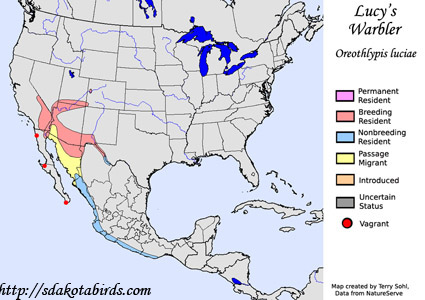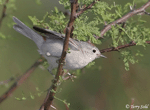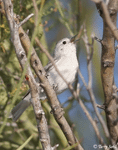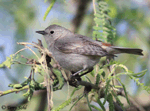Lucy's Warbler
Oreothlypis luciae
| Length: 4.25 inches | Wingspan: 7 inches | Seasonality: Non-resident in South Dakota |
| ID Keys: Light gray overall with rusty "cap" upper part of the base of the tail | ||
 The
Lucy's Warbler is a rather plain looking but unusual warbler of the deserts
of the American Southwest. They are the only warbler that summers and
nests in the Sonoran Desert region. They are the smallest of the North
American Warblers. The species was named for the daughter of
well-known ornithologist Spencer Fullerton Baird.
The
Lucy's Warbler is a rather plain looking but unusual warbler of the deserts
of the American Southwest. They are the only warbler that summers and
nests in the Sonoran Desert region. They are the smallest of the North
American Warblers. The species was named for the daughter of
well-known ornithologist Spencer Fullerton Baird.
Habitat: Lucy's Warblers are most often found in and around streamside vegetation or in vegetation near usually dry drainage areas such as desert washes.
Diet: Feeds almost entirely on insects.
Behavior: Most foraging is done by clambering through the foliage of desert trees and shrubs, searching for insects. On occasion they will also fly out to capture insects in mid-air.
Nesting: The nest of a Lucy's Warbler is in usually in a tree cavity such as an old woodpecker hole, or in the crevices of loose bark. The nest is made of fine grasses and weeds, strips of bark, and the leaf stems of mesquite trees. The female is thought to do the majority of the incubation of the eggs, but both parents forage for food and help to raise the young.
Song: The song of a Lucy's Warbler is a constant trill with period changes in pitch.
Migration: Lucy's Warblers summer in parts of the southwestern U.S. and far northwestern Mexico. They move a relatively short distance into western Mexico for the winter.
Interactive eBird Map: Click here to access an interactive eBird map of Lucy's Warbler sightings
Similar Species: Unlikely to be mistaken for another warbler species. Most confusion would likely be with other small plain gray birds, such as Bell's Vireo, or Gnatcatcher species.
Conservation Status: The IUCN currently lists the Lucy's Warbler as a species of "Least Concern". Populations appear to be relatively stable, although local declines have been noted in areas of habitat loss.
Further Information: 1) Cornell's All About Birds - Lucy's Warbler
2) Audubon Field Guide - Lucy's Warbler
3) California Partners in Flight - Lucy's Warbler
Photo Information: May 2008 - Near Tucson, Arizona - Terry Sohl
| Click below for a higher-resolution map |
 |
| South Dakota Status: Non-resident in South Dakota |
Additional Lucy's Warbler Photos
Click for a higher-resolution version of these photos



